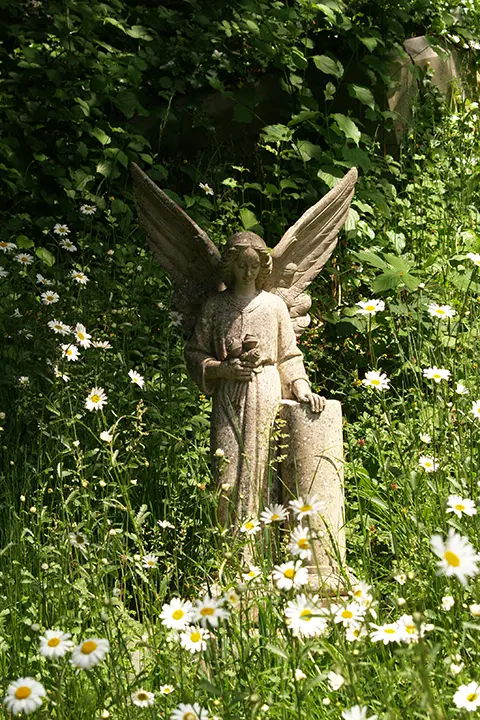The North London cemetery, Highgate Cemetery, is distinctive in history as the last haven for remarkable dignitaries and a picturesque sanctum with a rich life story. This famed burial field, positioned on the Highgate Hill slope, is proof of London’s swift urban evolution during the 19th century and the demand for more burial fields to ease the load on current cemeteries.
Key takeaways
- Highgate is one of London’s most popular cemeteries and has over 170,000 people buried in over 53,000 graves.
- Notable celebrities from Karl Marx to George Michael are buried in Highgate.
- Highgate is one of the most expensive cemeteries to be buried in.
- Guided tours are offered , although they do not cover all of grounds.
Table of contents
Design and location of Highgate Cemetery
Highgate Cemetery is located in London N6 within the borough of Camden; its layout and architecture distinguish it as one of London’s best-known cemeteries. The cemetery has over 170,000 people buried in over 53,000 graves. It was conceived as a response to the crowded and overfilled church graveyards, which demanded a solution to accommodate the increasing number of deaths. The London Cemetery Company, established in 1836, was responsible for establishing cemeteries around the metropolis, with Highgate Cemetery being one of their significant projects. Designed by founder and architect Stephen Geary, the cemetery’s planning and landscaping were carefully executed, featuring winding paths, monuments, abundant trees, and catacombs.
If the video does not play on this device please play on another.
Historical background and purpose
Highgate Cemetery falls under the “Magnificent Seven” graveyards, a batch of seven large, present-day cemeteries bordering central London. These graveyards were created in response to the unhygienic and scanty states of inner-city church burial places. Highgate Cemetery, devoted in 1839, aimed to offer a more stately resting field for the departed and handle the health dangers of overpopulated burial places. Its initial consecration included provisions for both Church of England and Dissenter burials. This new approach to burial grounds also reflected the Victorian attitude towards death and commemorating the deceased.

Consecration and early burials
Highgate Cemetery’s consecration in 1839 marked the beginning of a new era in burial practices. The first burial in this resting place (that of Elizabeth Jackson of Soho) occurred on May 26, 1839. Highgate’s lush surroundings and picturesque landscape made it an attractive option for families seeking a final resting place for their loved ones. The cemetery quickly gained popularity, attracting wealthy individuals who desired an elegant and peaceful location for their burials.
Victorian attitudes towards death
The Victorian era created a romanticised attitude towards death and mourning, shaping the design and ambiance of cemeteries like Highgate. This period witnessed the creation of elaborate tombs, monuments, and Gothic structures that conveyed a sense of grandeur and permanence. Highgate Cemetery embraced this trend, resulting in the establishment of ornate memorials and impressive architectural features.
In addition, the cemetery’s south-facing hillside location, adjacent to Waterlow Park, offered a serene environment for these artistic expressions of grief and commemoration. This picturesque setting and cultural significance secured Highgate Cemetery’s status as a Grade-I-listed historic park and garden.
Notable burials
Highgate Cemetery’s grounds house the remains of several famous individuals who have left indelible marks on history. Among its notable residents is Karl Marx, the renowned philosopher and political theorist whose tomb has become a pilgrimage site for admirers and scholars. The cemetery is also the final resting place of Mary Ann Cross, the celebrated novelist who wrote under her pen name George Eliot.
Other prominent figures interred here include poet Christina Rossetti, scientist Michael Faraday, inventor William Friese-Greene, actor Bob Hoskins and singer George Michael. The diversity of individuals buried at Highgate reflects the cemetery’s cultural and historical significance.
Architectural features: Egyptian avenue and Circle of Lebanon
Highgate Cemetery boasts remarkable architectural features that contribute to its unique character. Notably, Egyptian Avenue and the Circle of Lebanon are Grade-I-listed buildings within the cemetery. Inspired by Egyptian motifs and designs, Egyptian Avenue is (serves as) an entrance to the Circle of Lebanon. This circle is notable for its vaults, tombs, and winding paths that go into the cemetery’s hilly terrain.
The Circle of Lebanon originally featured a 280 year old Cedar of Lebanon tree, a significant landmark, which sadly had to be cut down and replaced in 2019. These architectural elements are aesthetically captivating and provide insights into the prevailing artistic trends of the era.
Expansion and additional sections
As the demand for burial space grew, Highgate Cemetery underwent expansion. In 1854, an additional 19 acres of land were acquired to create the eastern part of the cemetery, which opened in 1860. This expansion allowed for the accommodation of more burials and ensured the continuity of Highgate Cemetery’s legacy as a place of interment and commemoration. This new section demonstrated the ongoing relevance of the cemetery in meeting the evolving needs of the city’s residents.
Ownership and management
Highgate Cemetery is owned and serviced by the Friends of Highgate Cemetery Trust, a philanthropic group created in 1975. This trust acquired the freehold of the East and West Cemeteries by 1981, ensuring the preservation and care of the cemetery’s grounds and structures. This ownership model reflects the community’s commitment to preserving the historical, cultural, and natural significance of Highgate Cemetery, making it accessible to both visitors and those who wish to be laid to rest at this remarkable London cemetery site.

Cost of burial at Highgate Cemetery
Highgate Cemetery’s historical importance and prestigious reputation come with a corresponding cost for burials. Research by the independent comparison service Funeralbooker indicated that Highgate Cemetery is a costly final resting place, with a burial charge of £18,325. This fee encompasses various aspects of burial, including the plot and the cost of digging. This cost places Highgate Cemetery at the very higher end of burial expenses, reflecting its significance and desirability as a place of eternal rest.
Eligibility for burial
Highgate Cemetery has specific rules regarding grave ownership and eligibility for burial. While this last resting area is open to any individual, the enlisted grave owner must meet the burial conditions.
Grave space at Highgate Cemetery can only be purchased for a forthcoming funeral. Grave space cannot be purchased in advance unless:
- You are over 80 years of age
- Or have a terminal illness
Space for cremated remains can only be purchased up to twelve months before the interment of the cremated remains Therefore it is not possible to order a space for a long time into the future.
For further details of Highgate Cemetery to discuss grave ownership, funerals, and burials contact Claire Freston on 0208 347 2471, or email: registrar@highgatecemetery.org. For general information email info@highgatecemetery.org or contact 0208 340 1834.
Grave search facility
For a fee, which is presently £40 you can find out if someone is buried in Highgate Cemetery with their grave search facility. For those interested the cemetery also offers volunteering programs.
Guided Tours
Highgate offers guided tours, however not all sections of the cemetery are open to public viewing. For instance the tombs and vaults located within the west cemetery are only for family/allowed members. Furthermore the west cemetery is only open via guided tour. Members of the public can visit the cemetery, however, you will have to pay an entrance fee unless you are a grave owner. For those interested the cemetery also offers volunteering programs.
Conclusion
Highgate Cemetery is a remarkable testament to Victorian attitudes toward death, architectural aesthetics, and the preservation of history. Its lush landscapes, a diverse range of notable residents, and architectural features like the Egyptian Avenue and Circle of Lebanon contribute to its allure as a historical and cultural landmark.
The cemetery’s significant role in accommodating London’s growing population during the 19th century reflects its enduring importance as a place of eternal rest and remembrance. In addition, Highgate Cemetery continues to welcome visitors seeking to explore its grounds and learn from its rich history, serving as a place of reflection, commemoration, and inspiration.




